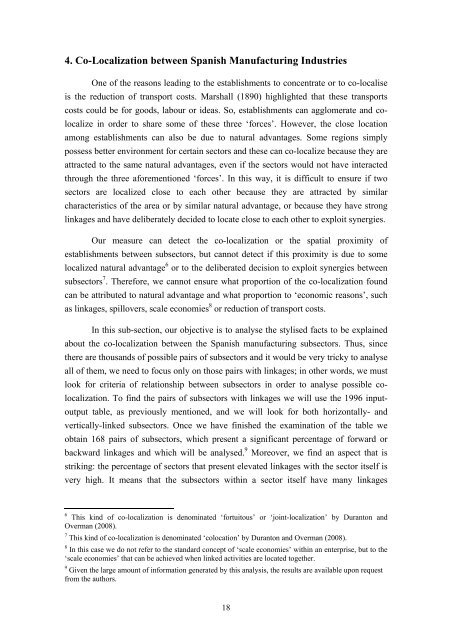Download PDF - Ivie
You also want an ePaper? Increase the reach of your titles
YUMPU automatically turns print PDFs into web optimized ePapers that Google loves.
4. Co-Localization between Spanish Manufacturing Industries<br />
One of the reasons leading to the establishments to concentrate or to co-localise<br />
is the reduction of transport costs. Marshall (1890) highlighted that these transports<br />
costs could be for goods, labour or ideas. So, establishments can agglomerate and colocalize<br />
in order to share some of these three ‘forces’. However, the close location<br />
among establishments can also be due to natural advantages. Some regions simply<br />
possess better environment for certain sectors and these can co-localize because they are<br />
attracted to the same natural advantages, even if the sectors would not have interacted<br />
through the three aforementioned ‘forces’. In this way, it is difficult to ensure if two<br />
sectors are localized close to each other because they are attracted by similar<br />
characteristics of the area or by similar natural advantage, or because they have strong<br />
linkages and have deliberately decided to locate close to each other to exploit synergies.<br />
Our measure can detect the co-localization or the spatial proximity of<br />
establishments between subsectors, but cannot detect if this proximity is due to some<br />
localized natural advantage 6 or to the deliberated decision to exploit synergies between<br />
subsectors 7 . Therefore, we cannot ensure what proportion of the co-localization found<br />
can be attributed to natural advantage and what proportion to ‘economic reasons’, such<br />
as linkages, spillovers, scale economies 8 or reduction of transport costs.<br />
In this sub-section, our objective is to analyse the stylised facts to be explained<br />
about the co-localization between the Spanish manufacturing subsectors. Thus, since<br />
there are thousands of possible pairs of subsectors and it would be very tricky to analyse<br />
all of them, we need to focus only on those pairs with linkages; in other words, we must<br />
look for criteria of relationship between subsectors in order to analyse possible colocalization.<br />
To find the pairs of subsectors with linkages we will use the 1996 inputoutput<br />
table, as previously mentioned, and we will look for both horizontally- and<br />
vertically-linked subsectors. Once we have finished the examination of the table we<br />
obtain 168 pairs of subsectors, which present a significant percentage of forward or<br />
backward linkages and which will be analysed. 9 Moreover, we find an aspect that is<br />
striking: the percentage of sectors that present elevated linkages with the sector itself is<br />
very high. It means that the subsectors within a sector itself have many linkages<br />
6 This kind of co-localization is denominated ‘fortuitous’ or ‘joint-localization’ by Duranton and<br />
Overman (2008).<br />
7 This kind of co-localization is denominated ‘colocation’ by Duranton and Overman (2008).<br />
8 In this case we do not refer to the standard concept of ‘scale economies’ within an enterprise, but to the<br />
‘scale economies’ that can be achieved when linked activities are located together.<br />
9 Given the large amount of information generated by this analysis, the results are available upon request<br />
from the authors.<br />
18

















